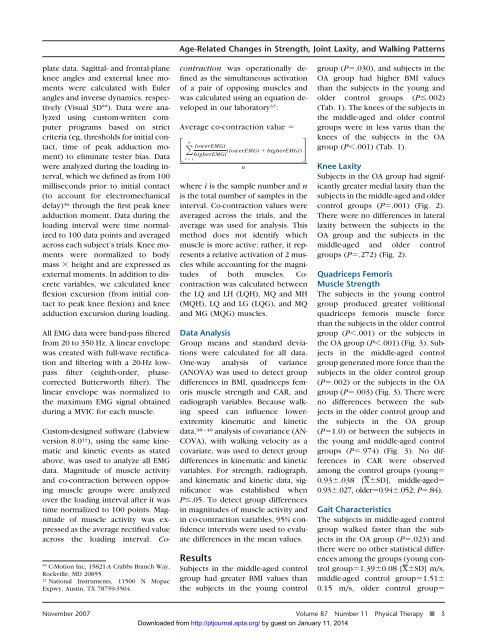Age-Related Changes in Strength, Joint Laxity, and Walking ...
Age-Related Changes in Strength, Joint Laxity, and Walking ...
Age-Related Changes in Strength, Joint Laxity, and Walking ...
Create successful ePaper yourself
Turn your PDF publications into a flip-book with our unique Google optimized e-Paper software.
<strong>Age</strong>-<strong>Related</strong> <strong>Changes</strong> <strong>in</strong> <strong>Strength</strong>, Jo<strong>in</strong>t <strong>Laxity</strong>, <strong>and</strong> Walk<strong>in</strong>g Patterns<br />
plate data. Sagittal- <strong>and</strong> frontal-plane<br />
knee angles <strong>and</strong> external knee moments<br />
were calculated with Euler<br />
angles <strong>and</strong> <strong>in</strong>verse dynamics, respectively<br />
(Visual 3D**). Data were analyzed<br />
us<strong>in</strong>g custom-written computer<br />
programs based on strict<br />
criteria (eg, thresholds for <strong>in</strong>itial contact,<br />
time of peak adduction moment)<br />
to elim<strong>in</strong>ate tester bias. Data<br />
were analyzed dur<strong>in</strong>g the load<strong>in</strong>g <strong>in</strong>terval,<br />
which we def<strong>in</strong>ed as from 100<br />
milliseconds prior to <strong>in</strong>itial contact<br />
(to account for electromechanical<br />
delay) 36 through the first peak knee<br />
adduction moment. Data dur<strong>in</strong>g the<br />
load<strong>in</strong>g <strong>in</strong>terval were time normalized<br />
to 100 data po<strong>in</strong>ts <strong>and</strong> averaged<br />
across each subject’s trials. Knee moments<br />
were normalized to body<br />
mass height <strong>and</strong> are expressed as<br />
external moments. In addition to discrete<br />
variables, we calculated knee<br />
flexion excursion (from <strong>in</strong>itial contact<br />
to peak knee flexion) <strong>and</strong> knee<br />
adduction excursion dur<strong>in</strong>g load<strong>in</strong>g.<br />
All EMG data were b<strong>and</strong>-pass filtered<br />
from 20 to 350 Hz. A l<strong>in</strong>ear envelope<br />
was created with full-wave rectification<br />
<strong>and</strong> filter<strong>in</strong>g with a 20-Hz lowpass<br />
filter (eighth-order, phasecorrected<br />
Butterworth filter). The<br />
l<strong>in</strong>ear envelope was normalized to<br />
the maximum EMG signal obta<strong>in</strong>ed<br />
dur<strong>in</strong>g a MVIC for each muscle.<br />
** C-Motion Inc, 15821-A Crabbs Branch Way,<br />
Rockville, MD 20855.<br />
††<br />
National Instruments, 11500 N Mopac<br />
Expwy, Aust<strong>in</strong>, TX 78759-3504.<br />
Custom-designed software (Labview<br />
version 8.0 †† ), us<strong>in</strong>g the same k<strong>in</strong>ematic<br />
<strong>and</strong> k<strong>in</strong>etic events as stated<br />
above, was used to analyze all EMG<br />
data. Magnitude of muscle activity<br />
<strong>and</strong> co-contraction between oppos<strong>in</strong>g<br />
muscle groups were analyzed<br />
over the load<strong>in</strong>g <strong>in</strong>terval after it was<br />
time normalized to 100 po<strong>in</strong>ts. Magnitude<br />
of muscle activity was expressed<br />
as the average rectified value<br />
across the load<strong>in</strong>g <strong>in</strong>terval. Cocontraction<br />
was operationally def<strong>in</strong>ed<br />
as the simultaneous activation<br />
of a pair of oppos<strong>in</strong>g muscles <strong>and</strong><br />
was calculated us<strong>in</strong>g an equation developed<br />
<strong>in</strong> our laboratory 37 :<br />
Average co-contraction value <br />
n<br />
i 1<br />
lowerEMGi<br />
higherEMGi <br />
lowerEMGi higherEMGi<br />
n<br />
where i is the sample number <strong>and</strong> n<br />
is the total number of samples <strong>in</strong> the<br />
<strong>in</strong>terval. Co-contraction values were<br />
averaged across the trials, <strong>and</strong> the<br />
average was used for analysis. This<br />
method does not identify which<br />
muscle is more active; rather, it represents<br />
a relative activation of 2 muscles<br />
while account<strong>in</strong>g for the magnitudes<br />
of both muscles. Cocontraction<br />
was calculated between<br />
the LQ <strong>and</strong> LH (LQH), MQ <strong>and</strong> MH<br />
(MQH), LQ <strong>and</strong> LG (LQG), <strong>and</strong> MQ<br />
<strong>and</strong> MG (MQG) muscles.<br />
Data Analysis<br />
Group means <strong>and</strong> st<strong>and</strong>ard deviations<br />
were calculated for all data.<br />
One-way analysis of variance<br />
(ANOVA) was used to detect group<br />
differences <strong>in</strong> BMI, quadriceps femoris<br />
muscle strength <strong>and</strong> CAR, <strong>and</strong><br />
radiograph variables. Because walk<strong>in</strong>g<br />
speed can <strong>in</strong>fluence lowerextremity<br />
k<strong>in</strong>ematic <strong>and</strong> k<strong>in</strong>etic<br />
data, 38–40 analysis of covariance (AN-<br />
COVA), with walk<strong>in</strong>g velocity as a<br />
covariate, was used to detect group<br />
differences <strong>in</strong> k<strong>in</strong>ematic <strong>and</strong> k<strong>in</strong>etic<br />
variables. For strength, radiograph,<br />
<strong>and</strong> k<strong>in</strong>ematic <strong>and</strong> k<strong>in</strong>etic data, significance<br />
was established when<br />
P.05. To detect group differences<br />
<strong>in</strong> magnitudes of muscle activity <strong>and</strong><br />
<strong>in</strong> co-contraction variables, 95% confidence<br />
<strong>in</strong>tervals were used to evaluate<br />
differences <strong>in</strong> the mean values.<br />
Results<br />
Subjects <strong>in</strong> the middle-aged control<br />
group had greater BMI values than<br />
the subjects <strong>in</strong> the young control<br />
group (P.030), <strong>and</strong> subjects <strong>in</strong> the<br />
OA group had higher BMI values<br />
than the subjects <strong>in</strong> the young <strong>and</strong><br />
older control groups (P.002)<br />
(Tab. 1). The knees of the subjects <strong>in</strong><br />
the middle-aged <strong>and</strong> older control<br />
groups were <strong>in</strong> less varus than the<br />
knees of the subjects <strong>in</strong> the OA<br />
group (P.001) (Tab. 1).<br />
Knee <strong>Laxity</strong><br />
Subjects <strong>in</strong> the OA group had significantly<br />
greater medial laxity than the<br />
subjects <strong>in</strong> the middle-aged <strong>and</strong> older<br />
control groups (P.001) (Fig. 2).<br />
There were no differences <strong>in</strong> lateral<br />
laxity between the subjects <strong>in</strong> the<br />
OA group <strong>and</strong> the subjects <strong>in</strong> the<br />
middle-aged <strong>and</strong> older control<br />
groups (P.272) (Fig. 2).<br />
Quadriceps Femoris<br />
Muscle <strong>Strength</strong><br />
The subjects <strong>in</strong> the young control<br />
group produced greater volitional<br />
quadriceps femoris muscle force<br />
than the subjects <strong>in</strong> the older control<br />
group (P.001) or the subjects <strong>in</strong><br />
the OA group (P.001) (Fig. 3). Subjects<br />
<strong>in</strong> the middle-aged control<br />
group generated more force than the<br />
subjects <strong>in</strong> the older control group<br />
(P.002) or the subjects <strong>in</strong> the OA<br />
group (P.003) (Fig. 3). There were<br />
no differences between the subjects<br />
<strong>in</strong> the older control group <strong>and</strong><br />
the subjects <strong>in</strong> the OA group<br />
(P1.0) or between the subjects <strong>in</strong><br />
the young <strong>and</strong> middle-aged control<br />
groups (P.974) (Fig. 3). No differences<br />
<strong>in</strong> CAR were observed<br />
among the control groups (young<br />
0.93.038 [XSD], middle-aged<br />
0.93.027, older0.94.052; P.84).<br />
Gait Characteristics<br />
The subjects <strong>in</strong> middle-aged control<br />
group walked faster than the subjects<br />
<strong>in</strong> the OA group (P.023) <strong>and</strong><br />
there were no other statistical differences<br />
among the groups (young control<br />
group1.390.08 [XSD] m/s,<br />
middle-aged control group1.51<br />
0.15 m/s, older control group<br />
November 2007 Volume 87 Number 11 Physical Therapy f 5<br />
Downloaded from http://ptjournal.apta.org/ by guest on January 11, 2014
















